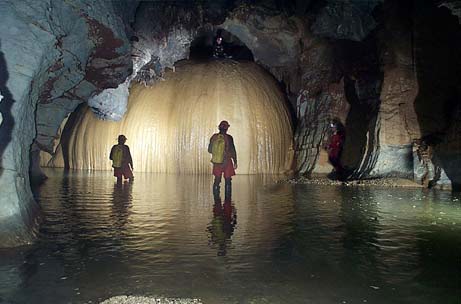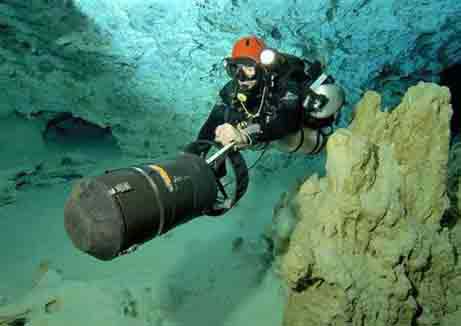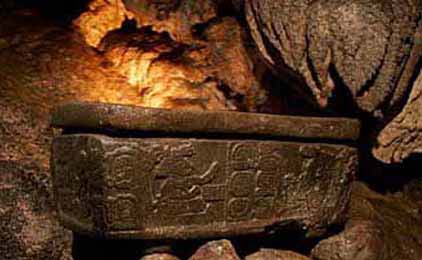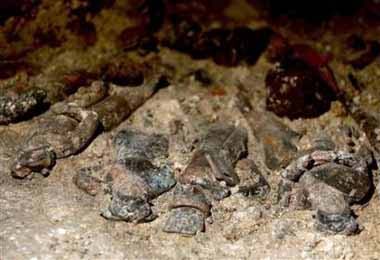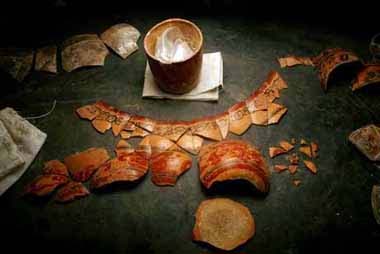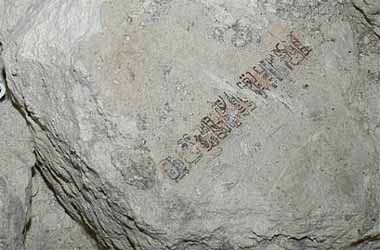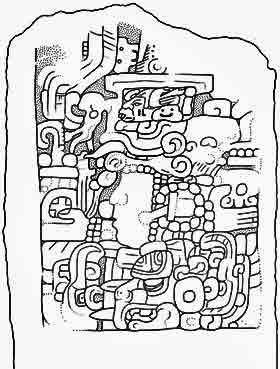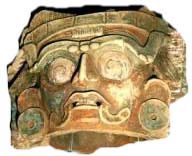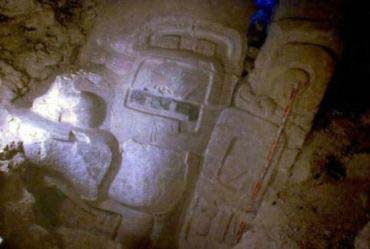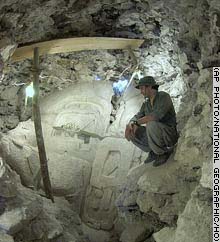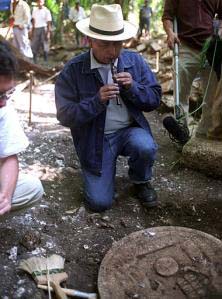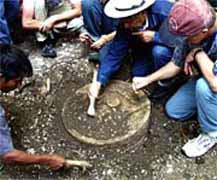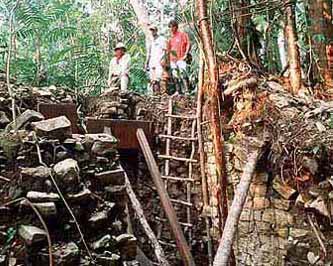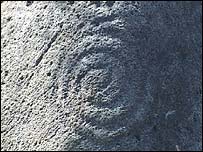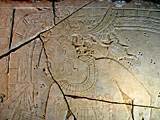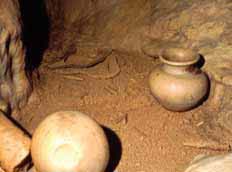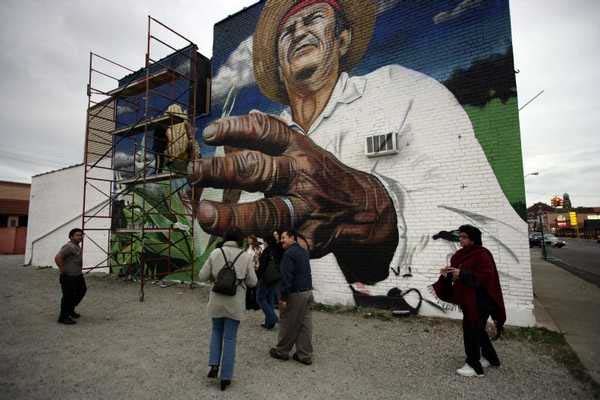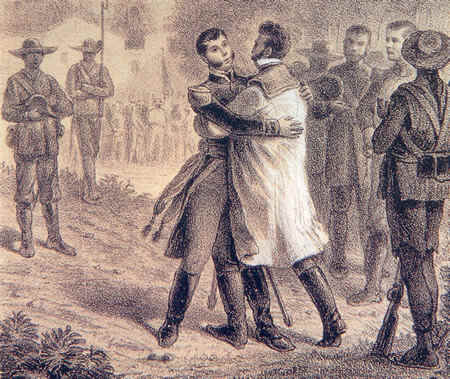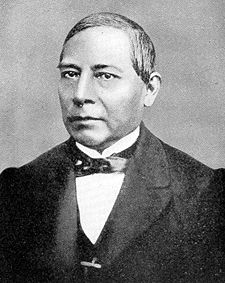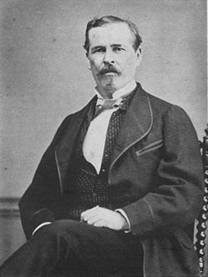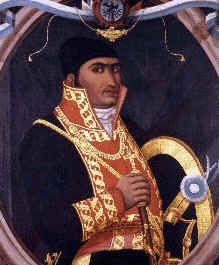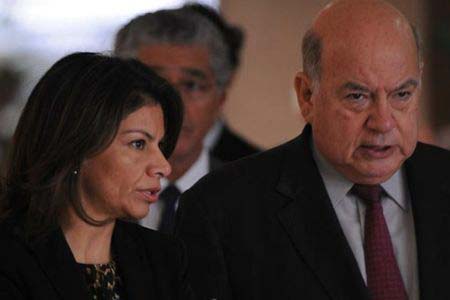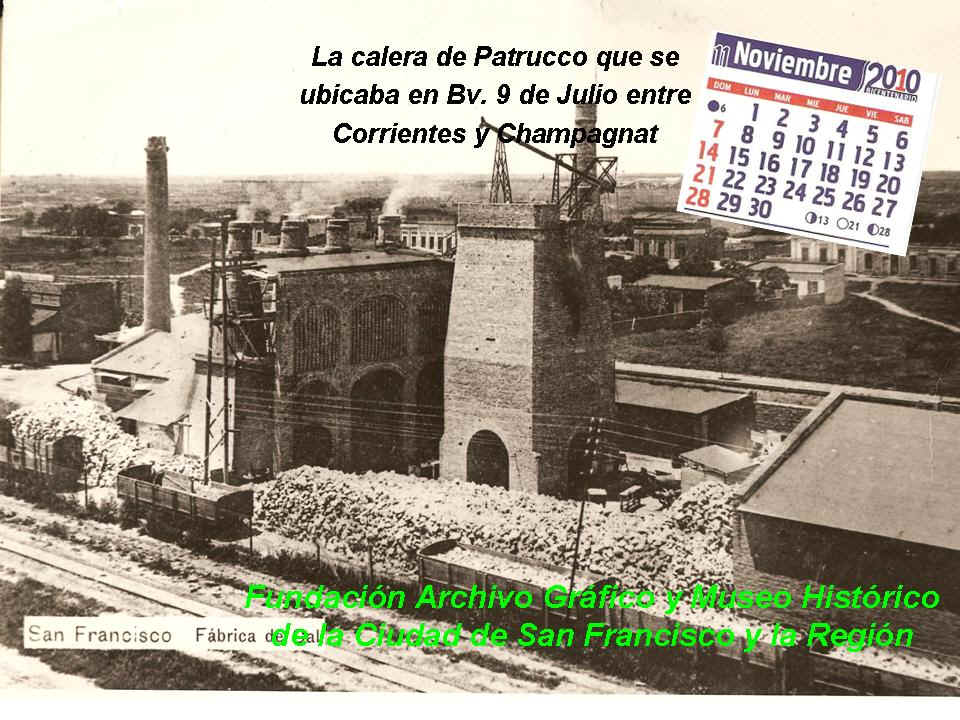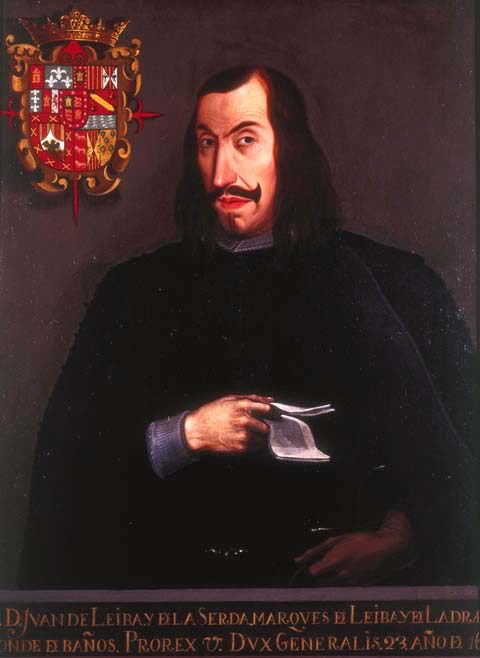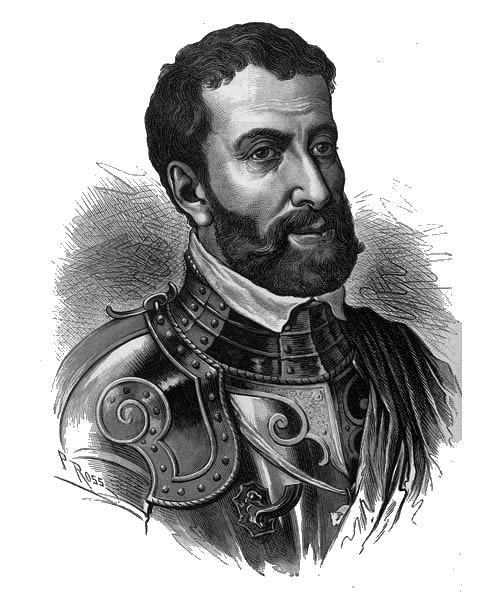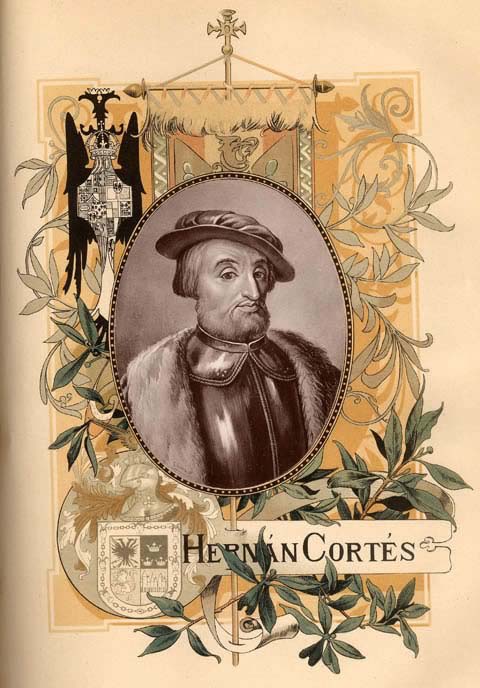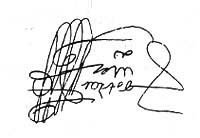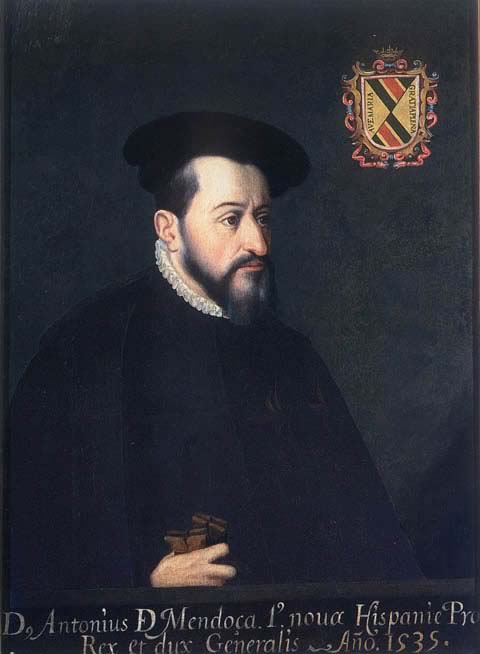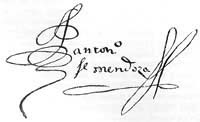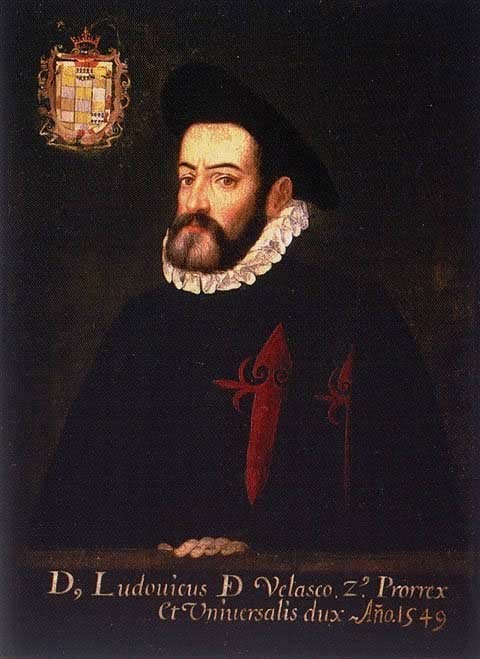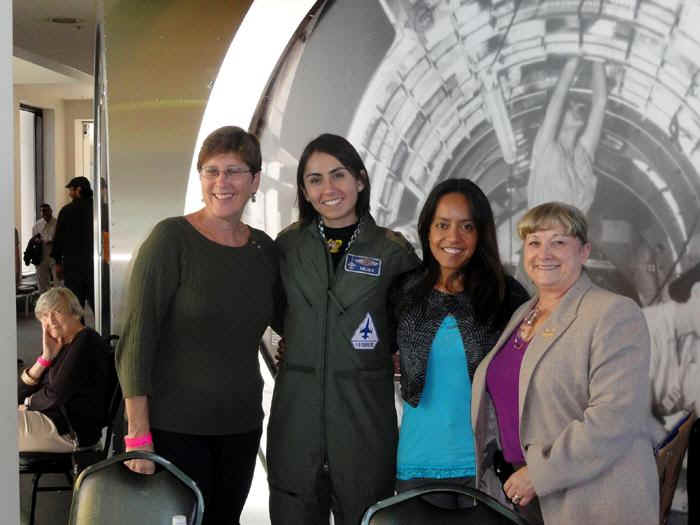|
SAGRARIO METROPOLITANO DE LA CD. DE MÉXICO, D.F.
En
diez y seis de Mayo de mil ochocientos veinte y dos por comisión
del Sor.Provisor Governador de la Sagrada Mitra, supuesta la
información producida de treinta y siete documentos. que obran
originales en el archivo de esta parroquia; Yo el D.D. Agustin
Yglesias, Cura mas antiguo de ella, bautizé subconditione al
general de Comanchis Voton de Fierro; pusele por nombres José,
Rafael, Guadalupe del Espiritu Santo, Manuel, Juan Nepomuceno,
originario y vecino de Brazos de Dios, Provincia del Oriente del
Obispado de Sonora, de edad de sesenta años, hijo legitimo de
Grulla Blanca y de Vitoalibe: casado según el rito de su nación
gentil con Maria Francisca Rivera, española cristiana; fueron sus
padrinos el Alcalde Constitucional de la Villa de Nuestra Señora de
Guadalupe, Capitan D. José Maria Parra y su esposa D. Luisa Lago
instruidos en su obligación.
Dor.Agustin Yglesias.
VILLA DE SANTIAGO DE LA MONCLOBA. ( MONCLOVA,
COAH. )
En
diez y nueve días del mes de mayo del año de mil y seiscientos y
ochenta y nueve años, yo el Br.
Dn. Thorivio Garzia de
Sierra Comissario del Sto. Oficio de la Ynquisicion; Cura
propio Vicario y Juez eclesiástico de la Villa de Santiago de la
Moncloba y Presidio de
Coaguila, Baptize solemnemente y puse Olio y Chrisma a Juana
yndia parbula de
nación Caveza, se la trujeron entre la pressa que se les dio a
dichos Cavezas y Tovosos, y la tiene------ Francisca de la Varrera española
fue su madrina Maria de la Cruz mulata criada del Sor. Govr. Alonsso
de Leon Cappn.
de este Presidio, a la qual y---- ha su ama encargue la
obligación que tenían de enseñar a la dicha niña
la Doctrina Christiana, y misterios de nuestra Santa Fee
Catholica y por ser verdad lo firme de mi ms. en este Presidio
dicho, dia, mes, y
año, vt. Supra.
Thorivio Garzia de Sierra.
En
diez, y nueve días de Enero de setenta, y ocho años yo el
infrascripto Capellan de este Real
Presidio de la Monclova baptizé solemnemente á un parbulo
de diez días nacido, a quien puse por nombre
José Manuel hijo
lexitimo de Damasio yndio de la Nacion de los Pausanes, y de Jacinta
de la Nacion Catujan. fueron
padrinos Blas Menchaca
soldado y Ma. Josefa Resendez,
a quienes advertí su obligacion y parentesco espiritual y para que
conste lo firme en dicho, dia, mes, y año, vt. Supra.
Fr. Manuel Montano.
En
siete de Octubre de setenta, y ocho años yo el infrascripto
Capellan de este Real Presidio de la Monclova baptizé solemnemente
á un parbulo de la Nacion Lipan el que me vendieron sus Padres con
consentimiento de los de su misma Nacion á quien puse por nombre
Francisco Antonio, fue padrino el Theniente de Agua Verde Dn.
Eugenio Blanco, á quien adverti´su obligación y cognación
espiritual y lo firmé,vt. Supra.
Fr. Manuel Montano.
En
diez días de Julio de Setenta, y nueve años yo el infrascripto
Capellan de este Real Presidio
de la Monclova, baptizé de
socorro á un yndio de la Nacion Apache por haver el dicho
pedido el baptismo con muchos deseos de recibirlo, y por
hayarse gravemente herido, y en peligro de morir; haviendole
cathequizado, é instruido en los principales misterios de nuestra
Sta. Fee cátholica, que necesitaba saber necesítate medij ad
salvandum y mostrar crecido amor a nuestra catolica Religion le puse
por nombre Nicolas. Fue padrino el Alferez de
este Presidio Dn. Pedro Lopez á quien advertí su obligación,
y parentesco espiritual y porque conste lo firme en dicho,dia,mes, y
año vt.supra. ( murió
el dicho en la Villa de Chihuahua )
Fr.
Manuel Montano
“
VALLE DE
SANTA ROSA MARIA DEL SANTISIMO SACRAMENTO, (MÚZQUIZ, COAH.) “
En seis días del mes de Abril de mil setecientos ochenta y nueve años,
en la Yglecia Parroquial de este Valle de Sta. Rosa. María del
Sacramento hayandose en el establecida
la Compañía de San Antonio de la Babia, y careciendo de Capilla
propria Baptizé solemnemente, en aquella, puse los Stos .Oleos y
Sagrado Chrisma á Maria Yrene
de los Dolores párvula de tres años de hedad yndia
de la nación Mezcalera, dada por el Sor. Comte. Gral. Coronel
Dn. Juan de Ugalde al Padre Capellan de esta Compañía Br.
Dn. Andres Ramon Lozano, fueron sus padrinos Da. Maria de Jesus Lobo
Guerrero aquien advertí su obligación, y parentesco espiritual, y
para que conste lo firmé.
Br. Andres Ramon Lozano.
En
dos días del mes de Septiembre de mil
setecientos noventa años en la Yglecia Parroquial de este Valle de
Sta.Rosa Maria del Sacramento hayandose en el establecida la Compañía
de San Antonio de la Babia, y careciendo de capilla propria Baptizé
solemnemente, en aquella, puse los Stos. Oleos, y Sagrado Chrisma á
Maria Catalina yndia párvula de tres años de hedad
conmensal, y de la Casa del Sor. Comte.Gral.Brigadier D. Juan de
Ugalde fueron sus padrinos el Teniente Dn. Juan Cortéz, y Da. Maria
Catalina de Urrutia. aquienes advertí su obligación, y parentesco
espiritual, y para que conste lo firmé.
Br.Andres Ramon Lozano.
En
tres días del mes de Octubre de mil setecientos noventa años en la
Yglecia Parroquial de este Valle de Sta. Rosa Maria del Sacramento,
hayandose en el establecida la Compañía de San Antonio de la Babia,
y careciendo de capilla propia Baptizé solemnemente
en aquella, puse los Stos. Oleos, y Sagrado Chrisma á Ysabel
Maria Yndia Gentil de la
Nacion Gileña adulta
de quince años de hedad cathequizada
e instruida en lo necesario para
servir el sacramento conmensal del Padre Capellan
Br. Dn. Andres Ramon Lozano dada por el Sor.Comte.Gral.
Brigadier Dn. Juan de Ugalde, fueron sus padrinos Da. Maria de Jesus
Lobo Guerrero aquien advertí su obligacion, y parentesco
espiritual y para que conste lo firmé.
Br. Andres Ramon Lozano.
En
diez días del mes de octubre de mil setecientos noventa años en la
Yglecia Parroquial de este Valle de Sta. Rosa Maria del Sacramento
hayandose en el establecida la Compañía de San Antonio de la Babia,
y careciendo de capilla propia Baptizé solemnemente, en aquella,
puse los Stos .Oleos, y Sagrado Chrisma á
José Maria yndio
párvulo de tres años de hedad conmensal
de la Casa de José Rodriguez fueron
sus padrinos, el
Teniente Dn. Pedro Urrutia, y Da. Salomé de Urrutia aquienes adverti
su obligación, y parentesco espiritual, y para que conste lo firmé.
Br. Andres Ramon Lozano.
En
diez días del mes de Octubre de mil setecientos noventa
años en la Yglecia Parroquial de este Valle de Sta. Rosa
Maria del Sacramento, hayandose en el establecida la Compañía de
San Antonio de la Babia, y careciendo de capilla propia Baptizé
Solemnemente, en aquella, puse los Stos.Oleos y Sagrado Chrisma á
Jose Miguel yndio
adulto de doce años de hedad del Servicio del Teniente Dn. Jose Antonio
Musquez fueron sus
padrinos D. Jose Antonio Musquez, y Da. Rosalia Longoria aquienes
adverti su obligación y parentesco espiritual, y para que conste lo
firmé.
Br. Andres Ramon Lozano.
En
el Valle de Sta. Rosa Ma. del Sacramento a los veinte y ocho días
del mes de 9bre. de mil ochocientos treinta y ocho , yo el
Presbitero Juan Nepomuceno de Ayala Cura
interino de este y su jusridiccion Baptizé solemnemente puse
los Stos.Oleos y Sagrado Chrisma a José Antonio de Jesus; de tres
meses de nacido de la nación Lipana, de la casa del Sor. Teniente
Coronel Dn. Juan José Elguezabal,
fueron sus padrinos el Sor. Capitan de las Milicias Activas de la
Ciudad de el Saltillo Dn. Juan Bautista Elguezabal y Doña Margarita
Carrasco. aquienes advertí su obligacion y
parentesco espiritual y para que conste lo firmé.
En
la Yglesia Parroquial del Valle de Santa Rosa Ma. a treinta días
del mes de Marzo de mil ochocientos cuarenta y cuatro. Yo el
Presbitero Juan Nepomuceno de Ayala, Cura ynterino de
este y su jurisdicción. Bautisé Solemnemente puse Los
Santos Oleo y Sagrado Crisma a Maria Macedonia de los Dolores de
edad de treinta años de la Nación Comancha la
que fue catequizada y examinada en los Sagrados misterios de Nuestra
Santa Fe conmensal de la casa de Dn. Fernando Rodriguez, quien la
adopto por hija: fueron sus padrinos Dn.
Tomas Talamantes y Da.
Juana Francisca de
Yglesias, aquienes advertí su obligacion y parentesco espiritual y
para que conste lo firmé.
Juan Nepomuceno de Ayala
En
la Yglesia Parroquial del Valle de Sta. Rosa Ma. del Sacramento, a
diez y nueve días del mes de Octubre de mil ochocientos cuarenta y
cuatro, yo el Presbitero Juan Nepomuceno de Ayala Cura propio de
este y su jurisdicción, Baptizé solemnemente puse los Stos. Oleos
y Crisma a Ma. Andrea
Avelina adulta de edad
de diez y nueve años de nación AngloAmericana, hija de Santiago
Ban, fue catequizada y examinada en los Sagrados misterios de
Nuestra Santa Fé Catolica Apostolica Romana, la que después de
haver adjurado de todo lo que se opone a Nuestra Santa Fé fue
admitida al bautismo, es
hija de Salome-------- fueron
sus padrinos Dn. Joaquin Zepulveda
y
Da. Ynes San Miguel los
que fueron advertidos del parentesco espiritual y la
obligación de Doctrina Christiana
y para que conste lo firmé.
En
la Yglesia Parroquial del Valle de Sta. Rosa
Ma. del Sacramento
a los veinte y cuatro días del mes de noviembre de mil ochocientos
cuarenta y seis, yo el Presbitero Juan Nepomuceno de Ayala cura
propio de este y su
jurisdicción, baptizé
solemnemente y puse los Santos Olios y Sagrado Crisma á Jose
Esteban de doce años de nacido hijo legitimo de Juan Antonio Neco
de la Tribu Wiliquisi y
de Ma. Antonia Jon de
la Tribu Ais, fueron los
padrinos D. Leon Griego a quien advertí la
obligación y parentesco espiritual
y para que conste lo firme.
Nota.
En esta misma página se encuentra el bautismo de Luisa Neco Johon.
En
la Yglesia Parroquial de la Villa de Santa Rosa Maria de Muzquiz a
los trece días del mes de junio de mil ochocientos sincuenta, yo el
Presvitero Juan Nepomuceno de Ayala cura propio de esta Villa y su
jurisdicción, baptizé
solemnemente puse los Santos Oleos
y Sagrado Chrisma,
a una Yndia de la Nacion Comanche; Adulta de diez y nueve años de
la casa del Sor. Coronel
D. Francisco de Castañeda Comandante Militar de la Colonia Militar
de San Vicente: fueron sus padrinos Dn.
Amarante Ximenez y Da.
Adelaida Elizondo; aquienes advertí su obligación y parentesco
espiritual y para que conste lo firmé.
Juan Nepomuceno de Ayala
En
la Yglesia Parroquial del Valle de Santa Rosa Ma. del Sacramento
a los veinte y cuatro días
del mes de Enero de mil ochocientos sinquenta y cuatro, yo el
Presvitero Juan Nepomuceno de Ayala cura propio de este y su
jurisdicción, baptizé solemnemente puse los Santos Oleos y Sagrado
Chrisma a Ma. Gertrudis de un mes de nacida, hija de de Tomas. Negro
de la Emigración de los
Estados Unidos del Norte, y de Rosa. Negra de la misma Emigracion,
fueron sus padrinos Dn. José Muzquiz y
Da. Gertrudis Garinzuay;
aquienes advertí su
obligacion y parentesco espiritual y para que conste lo firmé.
Juan Nepomuceno de Ayala.
En
la Yglesia Parroquial del Valle de Santa Rosa Ma. del Sacramento
a los veinte y ocho días del mes de Abril de mil ochocientos
sincuenta y cuatro. Yo el Presvitero Juan Nepomuceno de Ayala cura
propio de este y su jurisdicción. Baptizó solemnemente puse los
Santos Oleos y Sagrado Chrisma a José Diego de un mes quince días
de nacido hijo de Juana de la Cruz
Yndia Seminole. fueron sus padrinos Dn. Manuel Flores y Ma.
Nasaria Flores, aquienes advertí su obligacion y parentesco
espiritual y para que conste lo firme.
Juan Nepomuceno de Ayala.
En
la Yglesia Parroquial de Santa Rosa de Muzquiz, a once de setiembre
de mil ochocientos setenta
y cuatro, el Pe. Dn.
Jose Maria Hinojosa, vicario Foraneo, bautizó solemnemente puse el
Santo Oleo y Crisma a un
adulto de la Tribu Quicapú (
estando suficientemente
instruido en lo necesario para el baustimo) de dose años de edad á
quien puse por nombre Alfonso Maria fue su padrino el Cura de esta
Parroquia y para constancia lo firmé.
Sinforiano
Villarreal
En
la Yglesia Parroquial de Santa Rosa de Muzquiz a once de setiembre
de mil ochocientos setenta y cuatro, el Pe. Dn. José Maria Hinojosa
Vicario Foraneo, bautizó solemnemente puso el Santo Oleo y Crisma
á un adulto de la Tribu Quicapú( estando suficientemente instruido
en lo necesario para el bautismo) de catorce años de edad á quien
puse por nombre José María, fue su padrino José María Flores á
quien se le advirtio su obligacion y parentesco espiritual y para
constancia lo firmé.
Sinforiano Villarreal.
En
la Yglecia Parroquial de Muzquiz, á veintiuno de de Junio de mil
ochocientos setenta y nueve, yo el Presbitero Sinforiano
Villarreal, cura de ella, bautizó solemnemente, puse los
Santos Oleos y Crisma
á un niño de dos años nacido de la tribu Mezcalero
capturado por el Teniente Coronel Garza
Galan en diciembre pasado
á quien puse por nombre Luis Gonzaga hijo adoptivo de D. Francisco
Berain y Velarde y de
Ma. Guadalupe Valdez: abuelos paternos
D. Nicolas Berain y
Carlota Velarde, M.M.
Nasario Valdez y Refugio Vargas. fueron sus
padrinos el Presbitero D. Sinforiano Villareal y Da. Ysidora
Villarreal y para que conste lo firmé.
Sinforiano Villarreal.
En
la Yglecia Parroquial de Santa Rosa de Muzquiz, á los seis días
del mes de Abril de mil ochocientos ochenta,
yo el Presbo. Sinforiano Villarreal Cura ynterino de ella
Bautizé solemnemente puse el Santo Oleo y Crisma á un niño de dos
años de edad á quien puse por nombre Nicacio indio de la raza
Mezcalero hijo de Leonardo Musquiz
Alzate, fue rescatado el día catorce de Diciembre de mil
ochocientos setenta y ocho; apricionado en San Carlos Municipalidad
de Ojinaga, Estado de Chihuahua, y adoptado, por Romulo Galan
por el mismo Alzate: fueron sus padrinos Jesus Galan
Castillon y Ma.
Gertrudis Galan.
á quienes se les advirtió su obligación y parentesco
espiritual y para que conste lo firmé.
Sinforiano Villarreal.
En
la Villa de S. J. de Savinas jurisdicción de esta Parroquia de
Santa Rosa de Musquiz, á los tres días del mes de Enero de mil
ochocientos ochenta y dos: Yó el Presbo. Pedro María Garza y
Garza, Cura encargado de ella, con licencia de la Vicaria Foranea dada
viva voce.el 28 de Dbre. de 81,
bautizé solemnemente en la Casa habitación del
Sr. Nemesio Rodriguez, á
Ma. Consolación de la tribu Lipana, capturada en el desierto
de Sto. Domingo el 17 de agosto de 81 por el Coronel
Pedro A. Valdez, quien le calculó un mes de nacida,
sus padres se ignoran: hija adoptiva de Ma. Clara Valdez.
Padrinos, la referida
madre adoptiva y D. Pedro A.
Valdez. Lo que firmo para constancia.
Pbro.Pedro Ma. Gza. y Gza.
En
la Villa de S. J. de Savinas, jurisdicción de ésta
Parroquia de Santa Rosa de Musquiz, á los tres días del mes
de Enero de mil ochocientos ochenta y dos. Yó el Presbo. Pedro María
Gza. y Gza. con
licencia de la Vicaria Foranea dado viva voce. El 28 de Dbre. de
81, bautizé
solemnemente en la Casa habitación del Sr. Nemesio Rodriguez
, á Ma. Librada de la
tribu Lipana, capturada en el desierto de Sto. Domingo
el 17 de agosto de
81 por el Coronel Pedro
A. Valdez, quien le calculó cuatro años de edad, sus padres se
ignoran: hija adoptiva de D. Pedro A. Valdez y Da. Luiza Braun,
quienes fueron sus padrinos, lo que firmo para constancia.
Pbro. Pedro Ma. Gza. y Gza.
VILLA DE SANTIAGO DE EL SALTILLO. (
SALTILLO, COAH. )
En
esta Sta. Parrochial Ygla. de la Villa de el Saltillo en veinte y
seis días de Febrero de mil setecientos noventa y un años, yo Fray
Antonio Verdin, actual guardian de el Convento de Sor. Sn. Jose- de
esta Villa, Venia Parrochi, Baptisé solemnemente
poniendo los Stos. Oleos a Josef Bernardo Francisco de Paula,
Adulto de edad de once años, bien instruido en los Rudimentos de
Nra. Sta. Fee Catholica, hijo de Padres Gentiles de la Nacion
Lipan: fueron sus padrinos el Capitan Dn. Phelipe Calzado y
Da. Ysabel Mata y Cos. aquienes instruí en su obligación, y para
su constancia lo firmo.
Br.
Josef Sanchez de Luna
Fray Jose Antonio Berdin.
VILLA DE SAN FERNANDO DE
AUSTRIA, ( ZARAGOZA,
COAH. )
En
quince de octubre de mil setecientos sincuenta y seis años, en esta
Yglesia Parroquial de S. Fernando, bautizé solemnemente,exorcize,puse
Santos Oleos y Chrisma con beneplácito
de sus Padres Gentiles á un niño Gentil Apache de cómo de quatro
años es hijo de Aricia si
de ca, y de su mujer Sas
alai, y le puse por nombre Diego: fueron sus padrinos Juan
Joseph Damian y Maria de los Dolores á quienes adverti su obligación
y parentesco espiritual, y lo firme.
Fr.
Antonio Aguilar.
En
veinte de Abril de mil setecientos sincuenta y siete años, en esta
Villa de S.Fernando bautizé solemnemente á un niño Apache como de
edad de quatro años, á quien puse por nombre Diego: es hijo
lexitimo de Xitascal, y
de Jasatie Clex, quienes dieron su consentimiento fueron padrinos
Joseph Santiago Navarro y Ma. Cantuna: á quienes adverti su
obligacion y parentesco espiritual; y lo firmé.
Fr.
Antonio Aguilar.
En
veinte de abril de mil
setecientos sincuenta y siete años, bautizé solemnemente,exorcizé
y puse santo oleo y Chrisma, con beneplácito de sus padres
Gentiles, á un niño Apache , de edad como de dos años y medio; le
puse por nombre Santiago: es hijo lexitimo de Nix yicó y de su
mujer Xixindé. Fueron
sus padrinos Juá de la Bara
y de Feliciana Ramona: á quienes adverti su obligación y
parentesco espiritual, y lo firmé.
Fr.
Antonio Aguilar.
En
el Real Presidio de Sn. Sabbas en treinta y un días del mes de
Marzo de Mil setecientos setenta y siete años, Yo el B. Dn.Mariano
Alcala Cappn. de el en la pila Baptismal de esta Real Capilla,
Baptizé solemnemente conferí los
Stos. Oleos y Sagrado Chrisma, a una párvula a quien puse por
nombre Maria de los
Dolores, hija lexma. de
Thomas Salinas yndio explorador y de Maria Ximenez : fue padrino el
Soldado Manuel Sanchez
á quien adverti su obligación y parentesco espiritual y para que
conste lo firmo.
Jph. Mariano Alcala.
En
la Villa de San Fernando en diez y siete días del mes de Octubre de
mil ochocientos siete Yo el Presbitero D. José Manuel Fernandez de
Rumayor, Cura Vicario y Juez Eclesiastico de dicha Villa, y Capellan
Real del Presidio de Agua Verde, Catequizé,Exorcizé, puse los
Stos.Oleos, y Sagrado Crisma, y bauptizé solemnemente á
una Neofita Adulta; Yndia de la Nacion Lipana a quien puse
por nombre Maria Antonia, adoptada en la casa de Da. Ma. Gertrudis
Ximenez, viuda del difunto Teniente Coronel D. Juan Bautista de
Elguezabal: fueron sus padrinos
el Presbitero Dn. José Cornelio de
Ayala, y Da. Petra Olibares, a quienes adverti
la obligacion y parentesco espiritual,
y para que conste lo firmé.
José Manuel Fernandez de Rumayor
REAL DE SAN PEDRO DE BOCA DE LEONES ( VILLALDAMA, N.L. )
En S. Pedro de Villaldama, el
16 de Enero de 1866 se presento ante el infrascrito, Parroco
propo. de esta un
hombre, como de 22 años, de la parcialidad Mascog ( encarte de
Seminole y Africano ) e hizo presente, que
haviendole faltado sus padres naturales, desde su infancia, los que
lo auxiliaron hasta que llegó a la edad de poder subsistir por si
mismo, no le enseñaron ningunas reglas de religión; pero que hallándose
en estos pueblos católicos de Sta. Rosa; San Fernando,
y Lampazos, hace cosa de catorce años, advirtió en su
interior un placer muy agradable, quando ve a los fieles se reúnen
en los templos á adorar á Dios todo poderoso que para dar mas
atención á esa mociones de su corazón y esperar con algún
fundamento participar de las gracias que Dios concede al que lo
busca de todo corazón, há deseado siempre recibir el Sto.
Sacramento del Bautismo, preparándose con aprender algunas
oraciones y comprender los misterios mas esenciales de la religión
cristiana; que su interés se aumenta desde que la autoridad lo
destino de Soldado por el peligro en que anda de perder la vida que
por tanto pide con todo su corazón le ministre el Sto. Sacramento
del bautismo.
Le
hise ver los embarasos, que se presentaban, para dar cuenta al
Prelado de su solicitud, pero instándome, segunda vez, con
espresiones, que parecía emanaban de lo mas profundo de su corazón;
y la tercera aún vertiendo algunas lagrimas, pasé a examinarlo en
todo lo que debe saber y entender un hombre, que se quiere adscribir
en la familia de Jesucristo, y haviendolo encontrado medianamente
instruido, investigue, si en su pueblo havia alguna costumbre de
practicar algunas
Ceremonias religiosas con los que nacian dijo que ninguna,
absolutamente havia visto el, todo el tiempo que vivió entre los de
su parcialidad, Recordando además, que S.S. y el Sor. Vicario
me dirigió una comunicación para que si,
o por el Vicario de Sabinas pasará á la Escondida de los
Cardenas, ( hará 5,
o 6 años ) á bautizar á todos los de la parcialidad, que
acaudillaba Juan Caballo, a donde pertenecía este que pidieron este
Sto.Sacramento, accedí á su petición,
y en testimonio de verdad estampo la partida
sigte=
En
S.Pedro de Villaldama el 18 de Enero de 1866, el infrascrito,Parroco
propio de esta: en función solemne y dando el nombre de Mariano de
Jesus, bautisé y puse el Sagrado Oleo y Chrisma á
un hombre de cosa de 22 años de la tribu Mascog, creado entre los
de aquel pueblo hasta la edad de 8 años, que de ahí en los lugares
de Sta. Rosa, Sn.
Fernando de Agua
Verde y Lampazos; ignora los nombres de sus Padres
y el punto donde nació, fue su padrino D. José Antonio Ayala,
vecino de Monterrey, á quien advertí su obligación y parentesco,
para con su ahijado,
para que conste lo firmo.- José Trinidad García.
San Luis Potosí, S.L.P. á
7 de Agosto de
2010.
El Tte. Corl. Intdte. Ret. Ricardo Raúl Palmerín Cordero.
Investigador de Genealogía e Historia.
|
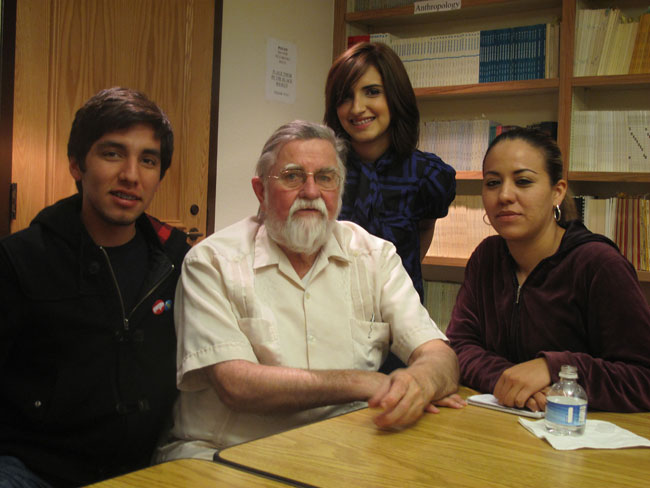
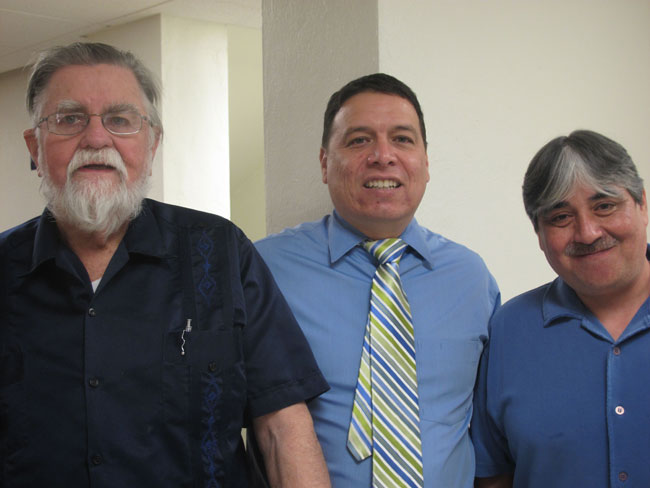 “I
knew a little more than how to order a beer when I went to
Mexico. It wasn’t until I went to my wife’s village that I
had to really learn to speak Spanish. If I wanted them to
laugh at my jokes, I needed to learn the language.”
“I
knew a little more than how to order a beer when I went to
Mexico. It wasn’t until I went to my wife’s village that I
had to really learn to speak Spanish. If I wanted them to
laugh at my jokes, I needed to learn the language.”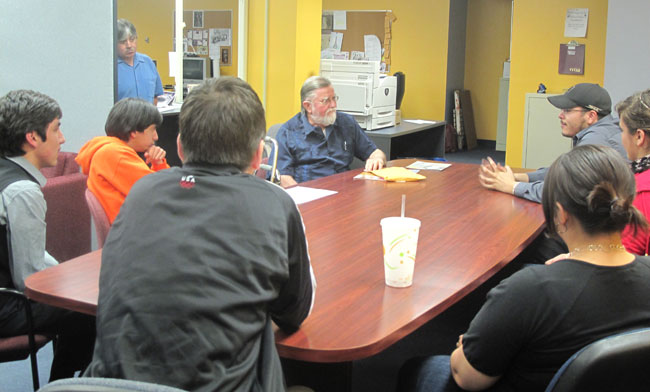 “I
want to continue [highlighting] all of the contributions the
Hispanic community makes to the U.S society. There are still
many positive stories to be written,” he said. “Oftentimes
editors like to focus on issues like immigration, drop out
rates and gangs, when there is so much more about this
community. We are here to write about that.”
“I
want to continue [highlighting] all of the contributions the
Hispanic community makes to the U.S society. There are still
many positive stories to be written,” he said. “Oftentimes
editors like to focus on issues like immigration, drop out
rates and gangs, when there is so much more about this
community. We are here to write about that.”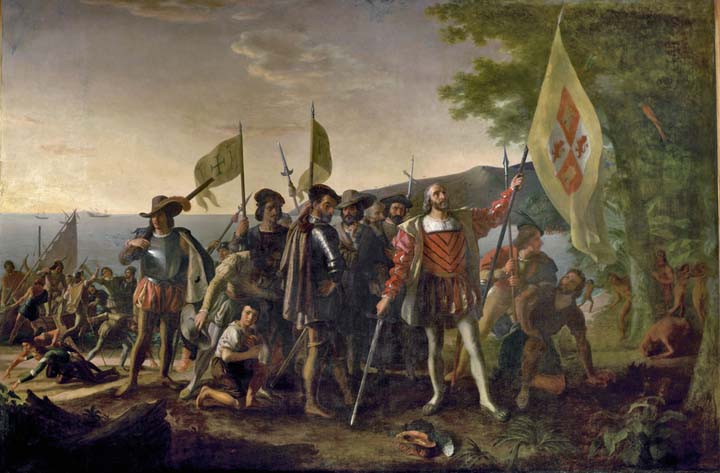

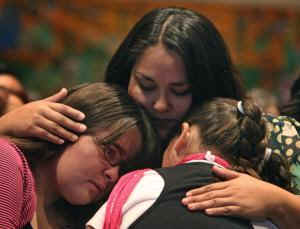
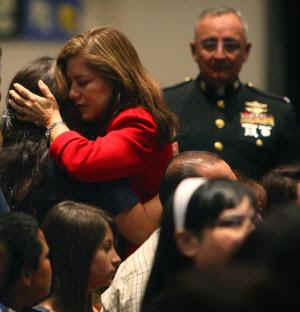
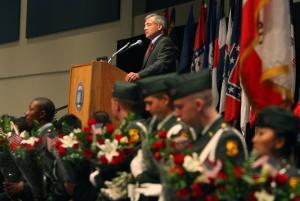
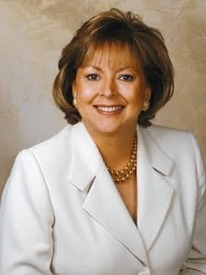
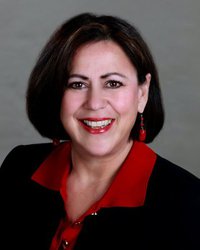
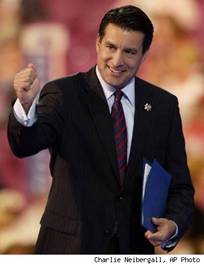
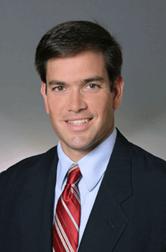
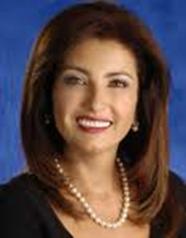
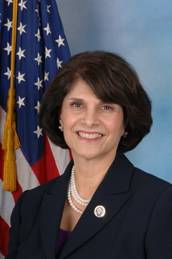
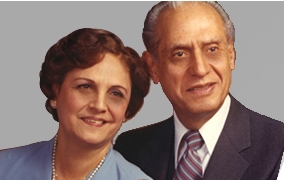
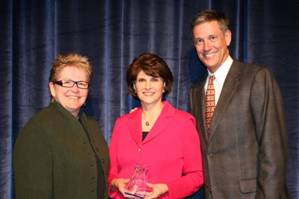
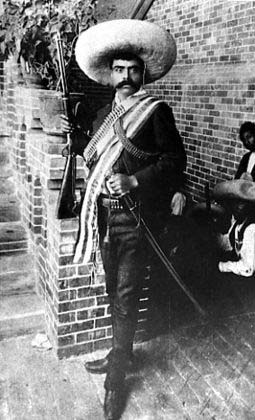
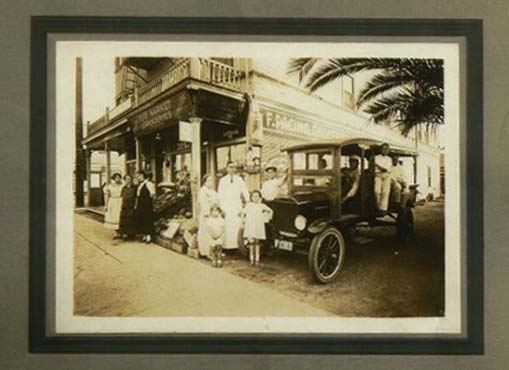
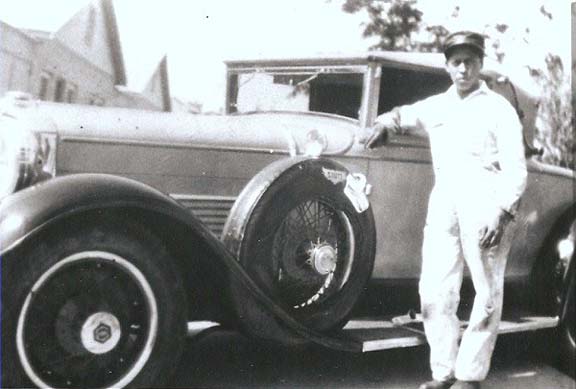
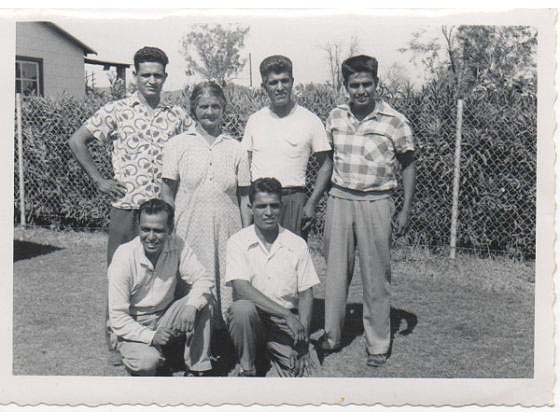
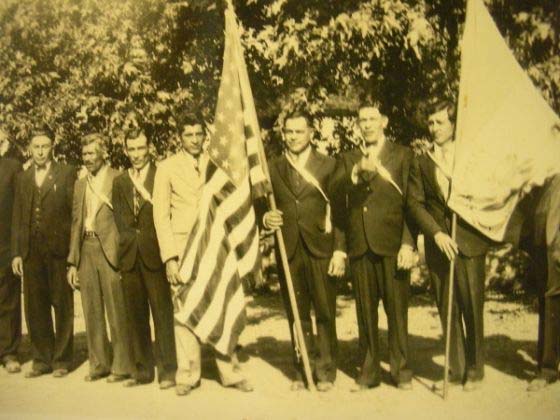
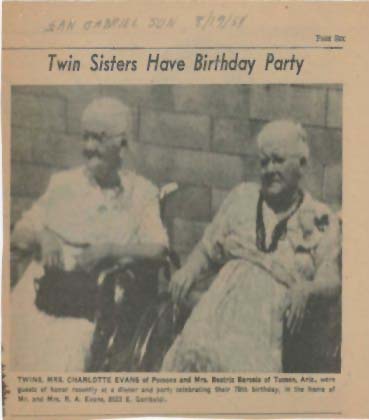
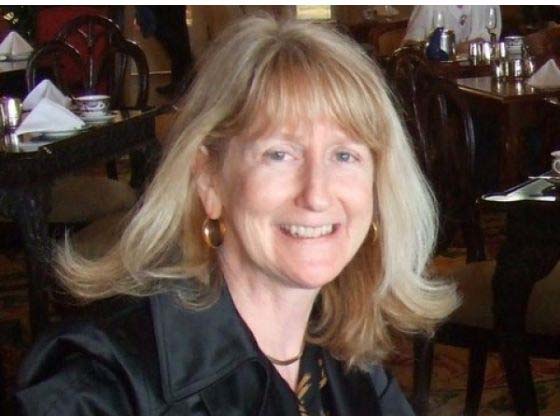
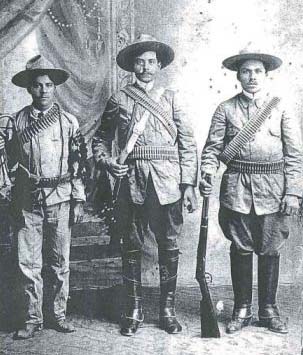
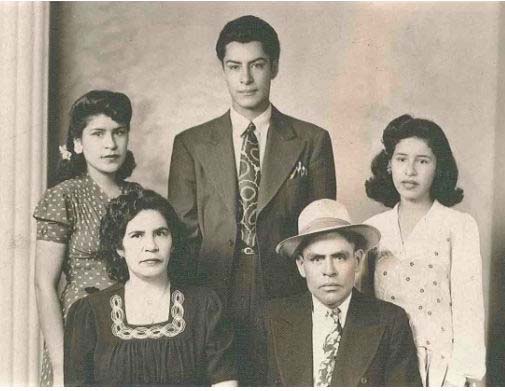
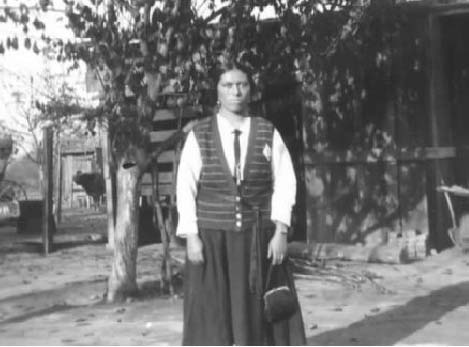
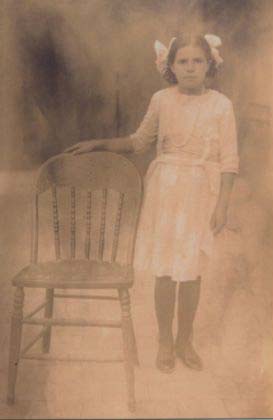
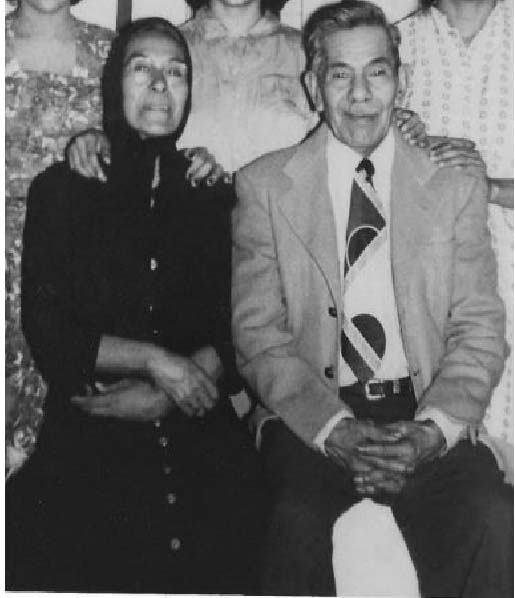
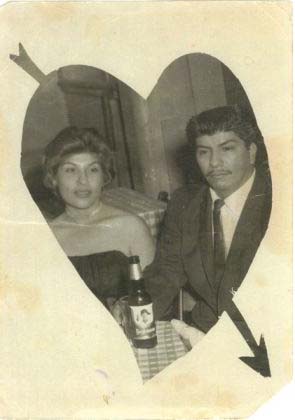
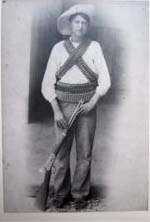
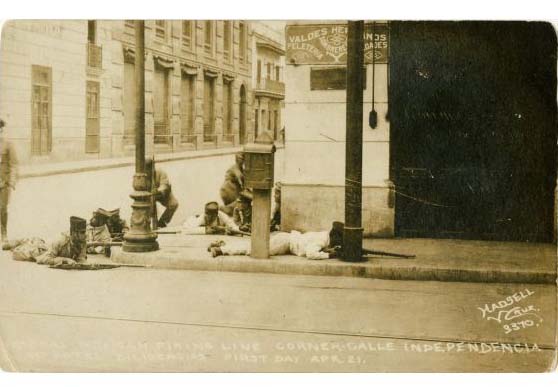
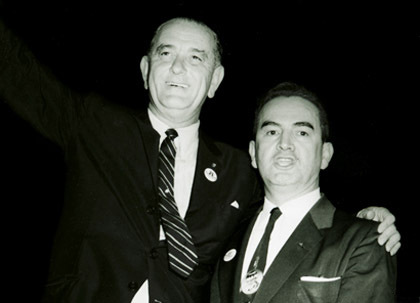

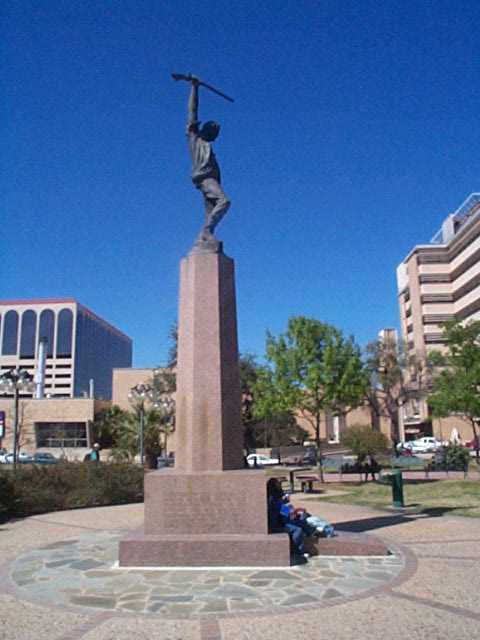
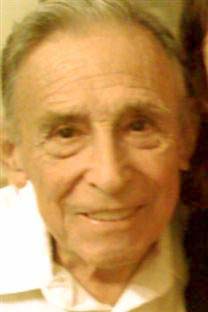
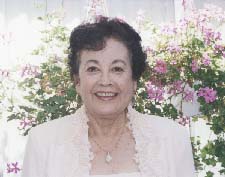
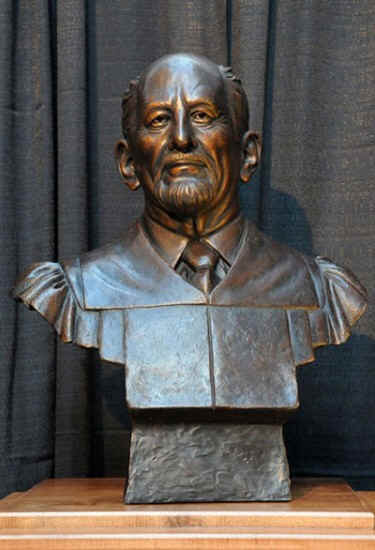
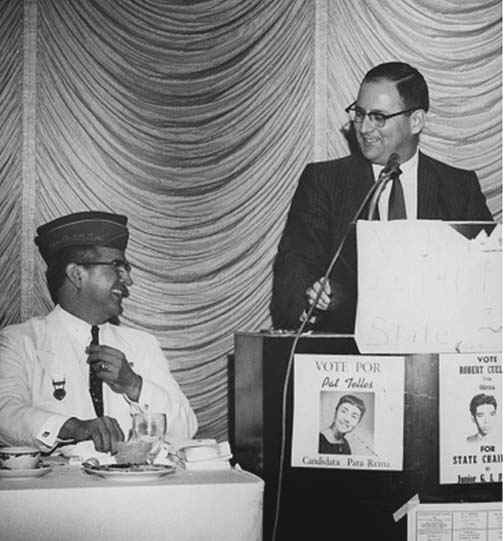 After
graduation from UT Law, DeAnda had problems finding work with Anglo law
firms.
After
graduation from UT Law, DeAnda had problems finding work with Anglo law
firms.



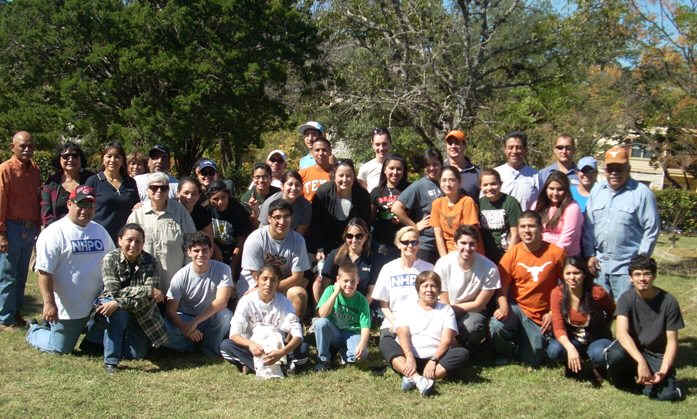
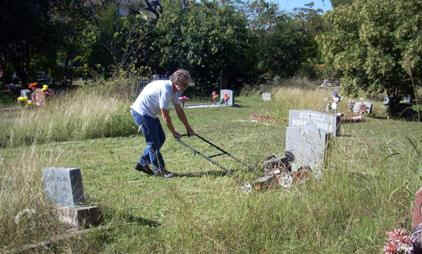
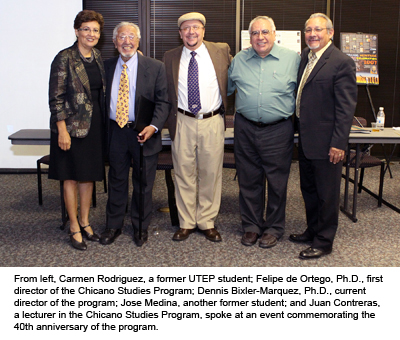 “We’ve
come a long way since then,” said Dennis Bixler-Marquez,
Ph.D., director of the University’s Chicano Studies
program.
“We’ve
come a long way since then,” said Dennis Bixler-Marquez,
Ph.D., director of the University’s Chicano Studies
program.
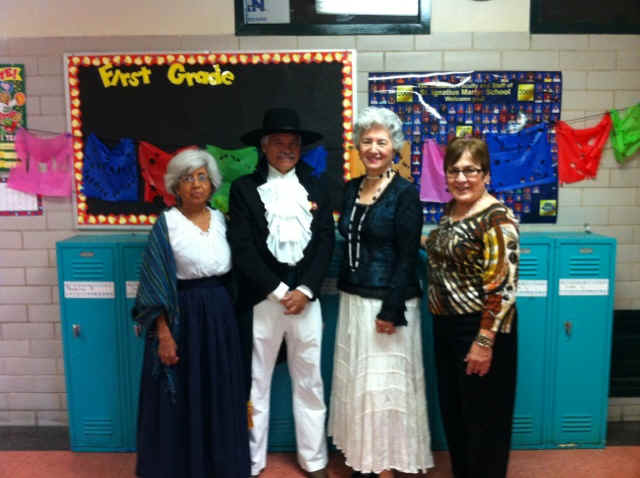
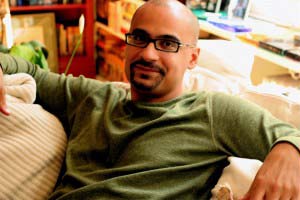
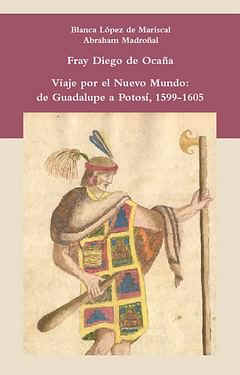
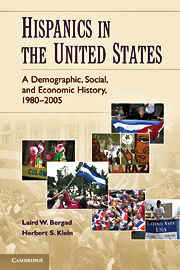
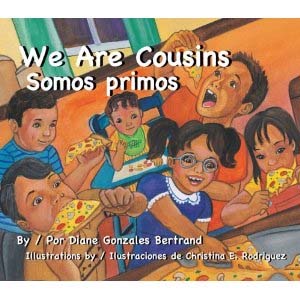
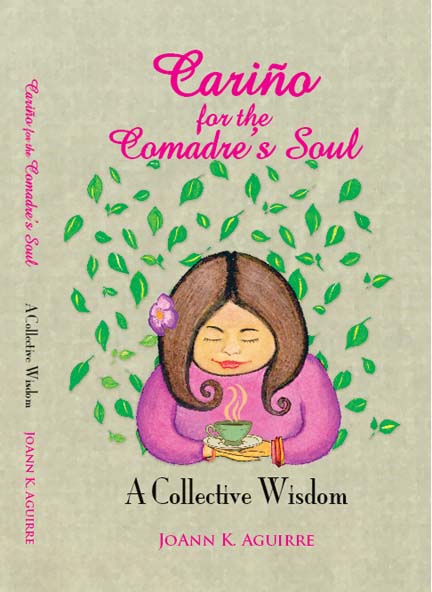
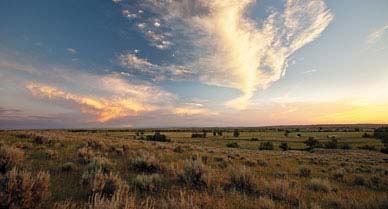
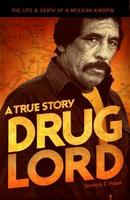
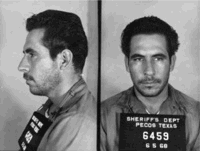 “Pablo Acosta was a living legend in his Mexican border town of
Ojinaga. He smuggled tremendous amounts of drugs into the United States;
he survived numerous attempts on his power--and his life--by rivals; and
he blessed the town with charity and civic improvements. He was finally
slain in 1987, during a raid by Mexican officials with the cooperation
of U.S. law enforcement. Poppa…has turned out a detailed and exciting
book, covering in depth Acosta's life; the other drug factions that
battled with him; the village of Ojinaga; and the logistics of the drug
operation. The result is a nonfiction account with enough greed,
treachery, shoot-outs, and government corruption to fascinate true crime
and crime fiction readers alike. Highly recommended.
“Pablo Acosta was a living legend in his Mexican border town of
Ojinaga. He smuggled tremendous amounts of drugs into the United States;
he survived numerous attempts on his power--and his life--by rivals; and
he blessed the town with charity and civic improvements. He was finally
slain in 1987, during a raid by Mexican officials with the cooperation
of U.S. law enforcement. Poppa…has turned out a detailed and exciting
book, covering in depth Acosta's life; the other drug factions that
battled with him; the village of Ojinaga; and the logistics of the drug
operation. The result is a nonfiction account with enough greed,
treachery, shoot-outs, and government corruption to fascinate true crime
and crime fiction readers alike. Highly recommended.
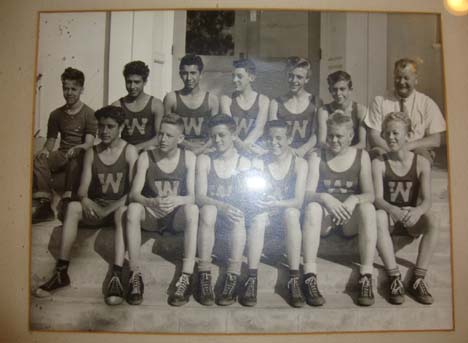
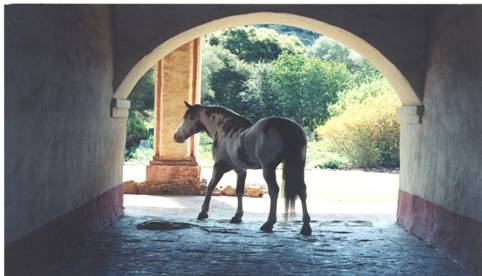
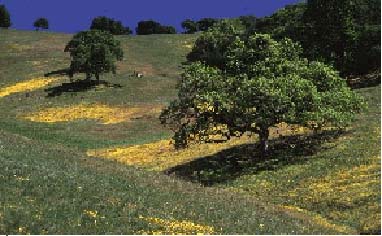 Stage
Line and was part of the first
Stage
Line and was part of the first 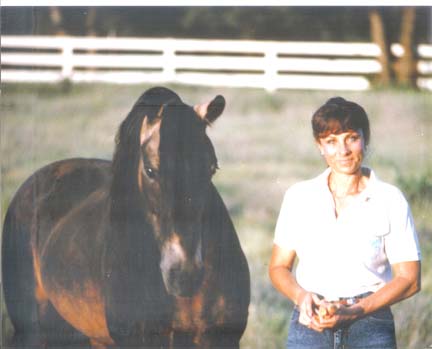 If
you go to our website, you have already taken a step to help us. There
are many things from here that you can do.
If
you go to our website, you have already taken a step to help us. There
are many things from here that you can do.
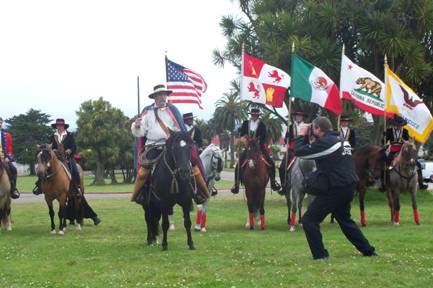
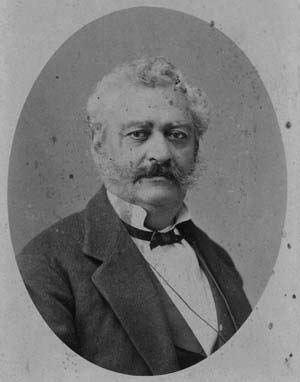
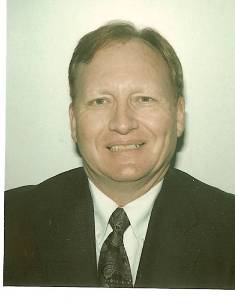
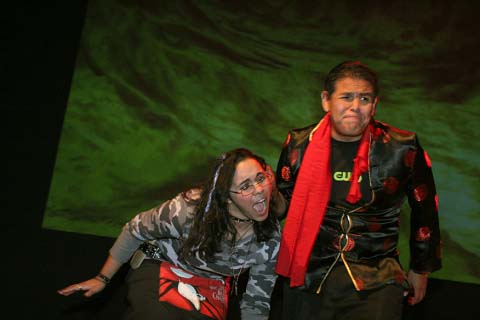
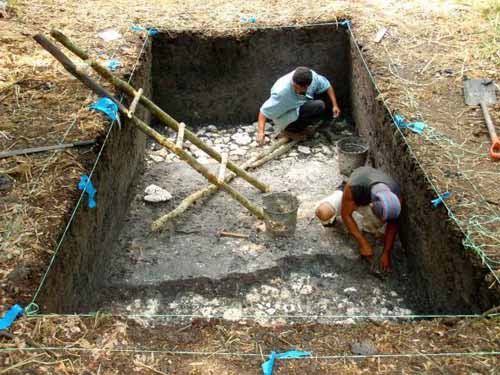 Archaeologists
from the University of Bonn have found a water reservoir the size of
a soccer field, whose floor is lined with ceramic shards, in the
Mexican rainforest. It seems that in combination with the limestone
on top, the shards were supposed to seal the artificial lake. The
system was built about 1,500 years ago. It is the first example of
this design found for the Maya. It is not yet known whether the
reservoir's entire floor is tiled.
Archaeologists
from the University of Bonn have found a water reservoir the size of
a soccer field, whose floor is lined with ceramic shards, in the
Mexican rainforest. It seems that in combination with the limestone
on top, the shards were supposed to seal the artificial lake. The
system was built about 1,500 years ago. It is the first example of
this design found for the Maya. It is not yet known whether the
reservoir's entire floor is tiled.
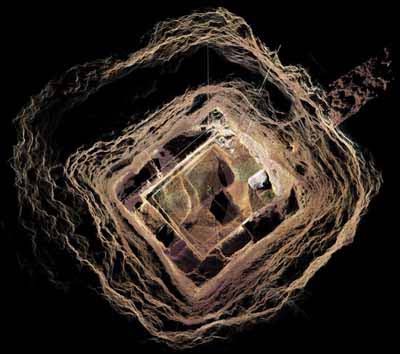
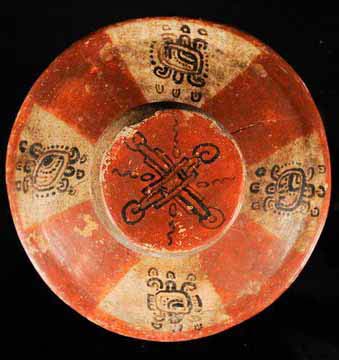
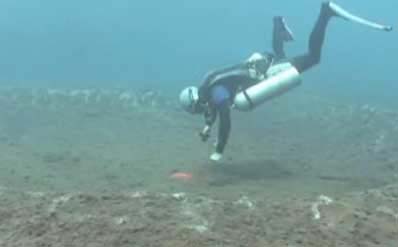
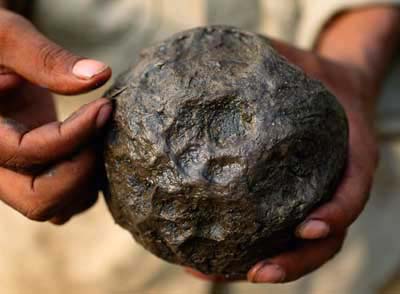
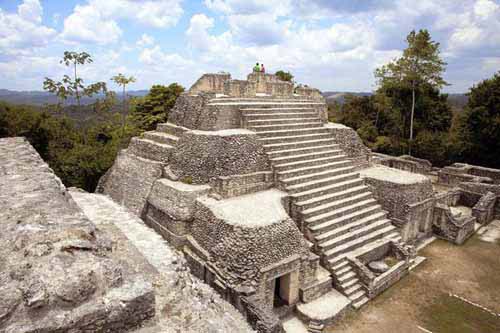
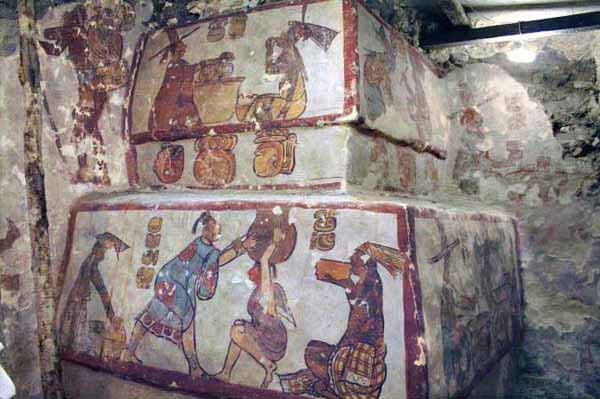
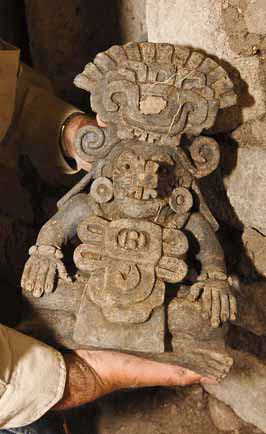
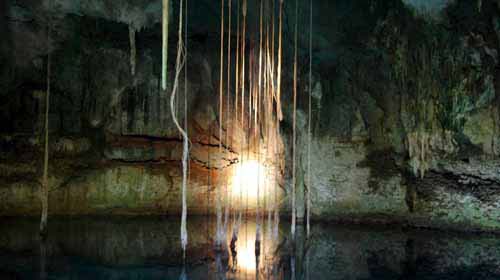
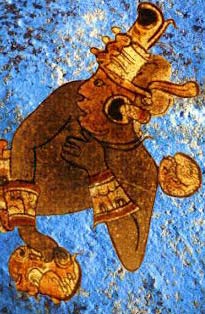
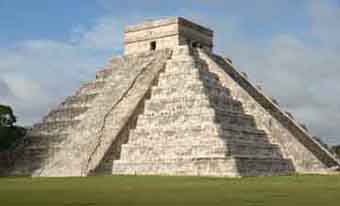
 Archaeologists
investigating the collapse of the Mayan civilization said Wednesday
that they used a satellite to uncover the ruins of hidden cities in
the Guatemalan jungle. The satellite can see through clouds and
forests to reveal differences in the vegetation below. The image
above was colored to help highlight patterns of jungle growth.
Archaeologists
investigating the collapse of the Mayan civilization said Wednesday
that they used a satellite to uncover the ruins of hidden cities in
the Guatemalan jungle. The satellite can see through clouds and
forests to reveal differences in the vegetation below. The image
above was colored to help highlight patterns of jungle growth.
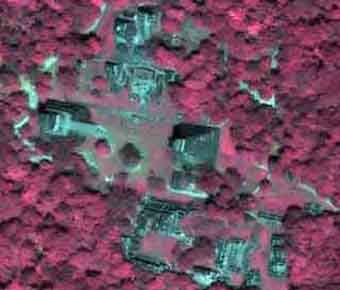
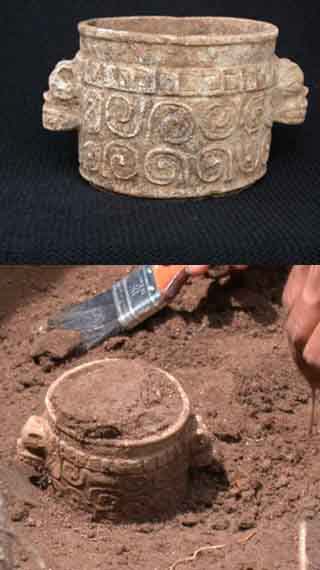
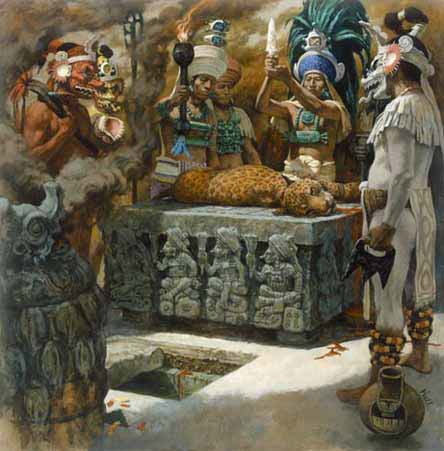
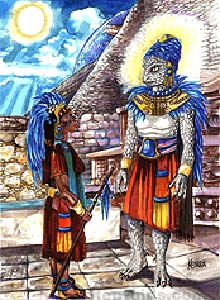 Ancient
Mexicans and Egyptians who never met and lived centuries and
thousands of miles apart both worshiped feathered-serpent deities,
built
Ancient
Mexicans and Egyptians who never met and lived centuries and
thousands of miles apart both worshiped feathered-serpent deities,
built 